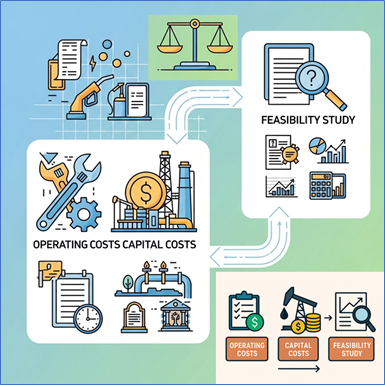
Capital Costs, Operating Costs and Feasibility Study: The Support for Technical Proposals
MEng. Rolando García Lugo
Prologue by Dr. Martín Essenfeld.
As the global hydrocarbon industry undertakes increasingly complex projects, it’s common for industry professionals to focus on the most modern, cutting-edge technologies and often overlook (or fail to give importance to) the simpler concepts that, in any event, underlie investment decisions in the exploitation of any field (simple or complex).
Thus, our professional practice, in any scenario—regardless of the complexity of the field and its conditions—always requires us to remain clear about the principles underlying decisions to exploit or not exploit discovered fields, recommend or deny the required investment, and, in general, support risky investment decisions related to any of the decisions related to these projects.
Thus, companies large and small, for large or small investments, invariably require an accurate assessment of the “potential return on investments that have not yet been made” as a basic procedure in making decisions about whether or not to proceed with the project under consideration.
For this reason, over the years, we have given our unequivocal support to the efforts of one of the most professionally trained Venezuelan petroleum engineers. He has been with EGEP CONSULTORES in the past and maintains ties to our company in the area of systematic, orderly, and reliable evaluation of projects of any size – Rolando García Lugo.
Thus, we increasingly observe that in the aforementioned Project Analysis (simple or complex), investment levels, operating costs, and risk factors related to the uncertainty of these parameters (and others) must be assessed very early on. Therefore, today, we offer EGEP CONSULTORES website followers, as the first publication, the original work entitled “Capital Costs, Operating Costs and Feasibility Study: The Support for Technical Proposals.”
As the title indicates, all technical investment proposals must be accompanied by their corresponding economic evaluation: This is a requirement even for Pilot Projects, which must evaluate (at risk) the future market for new technologies.
Hence the value we place on providing our followers with a systematic summary of what, “although obvious,” is often overlooked. This provides a clear understanding of the designation of the different categories of “estimates,” their level of uncertainty, and the differences between the surface facilities segment (and its uncertainties) versus the subsurface segment (and its uncertainties), which, when combined, are very different in the types of associated risks.
We anticipate that our followers will appreciate the clarity of the summary offered today, for the first time, by Engineer Rolando García Lugo.
Dr. Martin Essenfeld, August 2025.